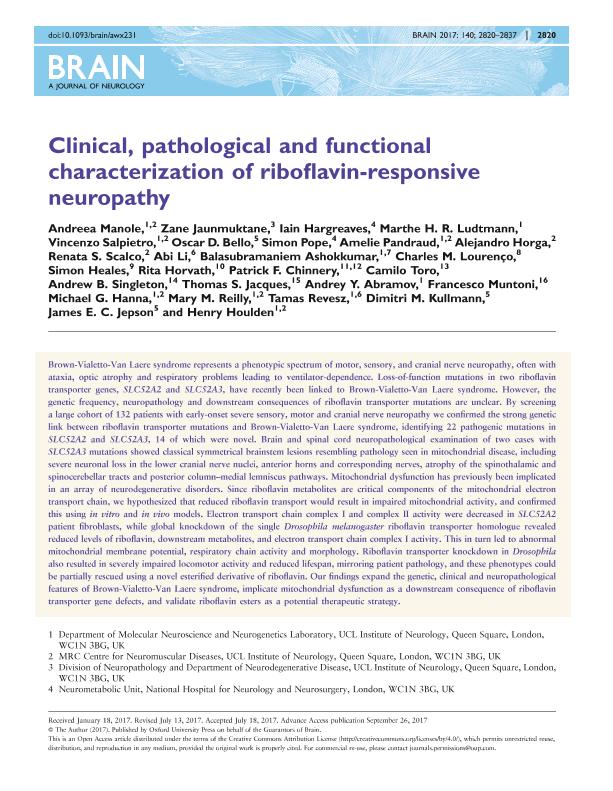Artículo
Clinical, pathological and functional characterization of riboflavin-responsive neuropathy
Manole, Andreea; Jaunmuktane, Zane; Hargreaves, Iain; Ludtmann, Marthe H. R.; Salpietro, Vincenzo; Bello, Oscar Daniel ; Pope, Simon; Pandraud, Amelie; Horga, Alejandro; Scalco, Renata S.; Li, Abi; Ashokkumar, Balasubramaniem; Lourenço, Charles M.; Heales, Simon; Horvath, Rita; Chinnery, Patrick F.; Toro, Camilo; Singleton, Andrew B.; Jacques, Thomas S.; Abramov, Andrey Y.; Muntoni, Francesco; Hanna, Michael G.; Reilly, Mary M.; Revesz, Tamas; Kullmann, Dimitri M.; Jepson, James E. C.; Houlden, Henry
; Pope, Simon; Pandraud, Amelie; Horga, Alejandro; Scalco, Renata S.; Li, Abi; Ashokkumar, Balasubramaniem; Lourenço, Charles M.; Heales, Simon; Horvath, Rita; Chinnery, Patrick F.; Toro, Camilo; Singleton, Andrew B.; Jacques, Thomas S.; Abramov, Andrey Y.; Muntoni, Francesco; Hanna, Michael G.; Reilly, Mary M.; Revesz, Tamas; Kullmann, Dimitri M.; Jepson, James E. C.; Houlden, Henry
 ; Pope, Simon; Pandraud, Amelie; Horga, Alejandro; Scalco, Renata S.; Li, Abi; Ashokkumar, Balasubramaniem; Lourenço, Charles M.; Heales, Simon; Horvath, Rita; Chinnery, Patrick F.; Toro, Camilo; Singleton, Andrew B.; Jacques, Thomas S.; Abramov, Andrey Y.; Muntoni, Francesco; Hanna, Michael G.; Reilly, Mary M.; Revesz, Tamas; Kullmann, Dimitri M.; Jepson, James E. C.; Houlden, Henry
; Pope, Simon; Pandraud, Amelie; Horga, Alejandro; Scalco, Renata S.; Li, Abi; Ashokkumar, Balasubramaniem; Lourenço, Charles M.; Heales, Simon; Horvath, Rita; Chinnery, Patrick F.; Toro, Camilo; Singleton, Andrew B.; Jacques, Thomas S.; Abramov, Andrey Y.; Muntoni, Francesco; Hanna, Michael G.; Reilly, Mary M.; Revesz, Tamas; Kullmann, Dimitri M.; Jepson, James E. C.; Houlden, Henry
Fecha de publicación:
11/2017
Editorial:
Oxford University Press
Revista:
Brain
ISSN:
0006-8950
Idioma:
Inglés
Tipo de recurso:
Artículo publicado
Clasificación temática:
Resumen
Brown-Vialetto-Van Laere syndrome represents a phenotypic spectrum of motor, sensory, and cranial nerve neuropathy, often with ataxia, optic atrophy and respiratory problems leading to ventilator-dependence. Loss-of-function mutations in two riboflavin transporter genes, SLC52A2 and SLC52A3, have recently been linked to Brown-Vialetto-Van Laere syndrome. However, the genetic frequency, neuropathology and downstream consequences of riboflavin transporter mutations are unclear. By screening a large cohort of 132 patients with early-onset severe sensory, motor and cranial nerve neuropathy we confirmed the strong genetic link between riboflavin transporter mutations and Brown-Vialetto-Van Laere syndrome, identifying 22 pathogenic mutations in SLC52A2 and SLC52A3, 14 of which were novel. Brain and spinal cord neuropathological examination of two cases with SLC52A3 mutations showed classical symmetrical brainstem lesions resembling pathology seen in mitochondrial disease, including severe neuronal loss in the lower cranial nerve nuclei, anterior horns and corresponding nerves, atrophy of the spinothalamic and spinocerebellar tracts and posterior column-medial lemniscus pathways. Mitochondrial dysfunction has previously been implicated in an array of neurodegenerative disorders. Since riboflavin metabolites are critical components of the mitochondrial electron transport chain, we hypothesized that reduced riboflavin transport would result in impaired mitochondrial activity, and confirmed this using in vitro and in vivo models. Electron transport chain complex I and complex II activity were decreased in SLC52A2 patient fibroblasts, while global knockdown of the single Drosophila melanogaster riboflavin transporter homologue revealed reduced levels of riboflavin, downstream metabolites, and electron transport chain complex I activity. This in turn led to abnormal mitochondrial membrane potential, respiratory chain activity and morphology. Riboflavin transporter knockdown in Drosophila also resulted in severely impaired locomotor activity and reduced lifespan, mirroring patient pathology, and these phenotypes could be partially rescued using a novel esterified derivative of riboflavin. Our findings expand the genetic, clinical and neuropathological features of Brown-Vialetto-Van Laere syndrome, implicate mitochondrial dysfunction as a downstream consequence of riboflavin transporter gene defects, and validate riboflavin esters as a potential therapeutic strategy.
Palabras clave:
BROWN-VIALETTO-VAN LAERE SYNDROME
,
RIBOFLAVIN
,
SLC52A2
,
SLC52A3
Archivos asociados
Licencia
Identificadores
Colecciones
Articulos(IHEM)
Articulos de INST. HISTOLOGIA Y EMBRIOLOGIA DE MEND DR.M.BURGOS
Articulos de INST. HISTOLOGIA Y EMBRIOLOGIA DE MEND DR.M.BURGOS
Citación
Manole, Andreea; Jaunmuktane, Zane; Hargreaves, Iain; Ludtmann, Marthe H. R.; Salpietro, Vincenzo; et al.; Clinical, pathological and functional characterization of riboflavin-responsive neuropathy; Oxford University Press; Brain; 140; 11; 11-2017; 2820-2837
Compartir
Altmétricas



